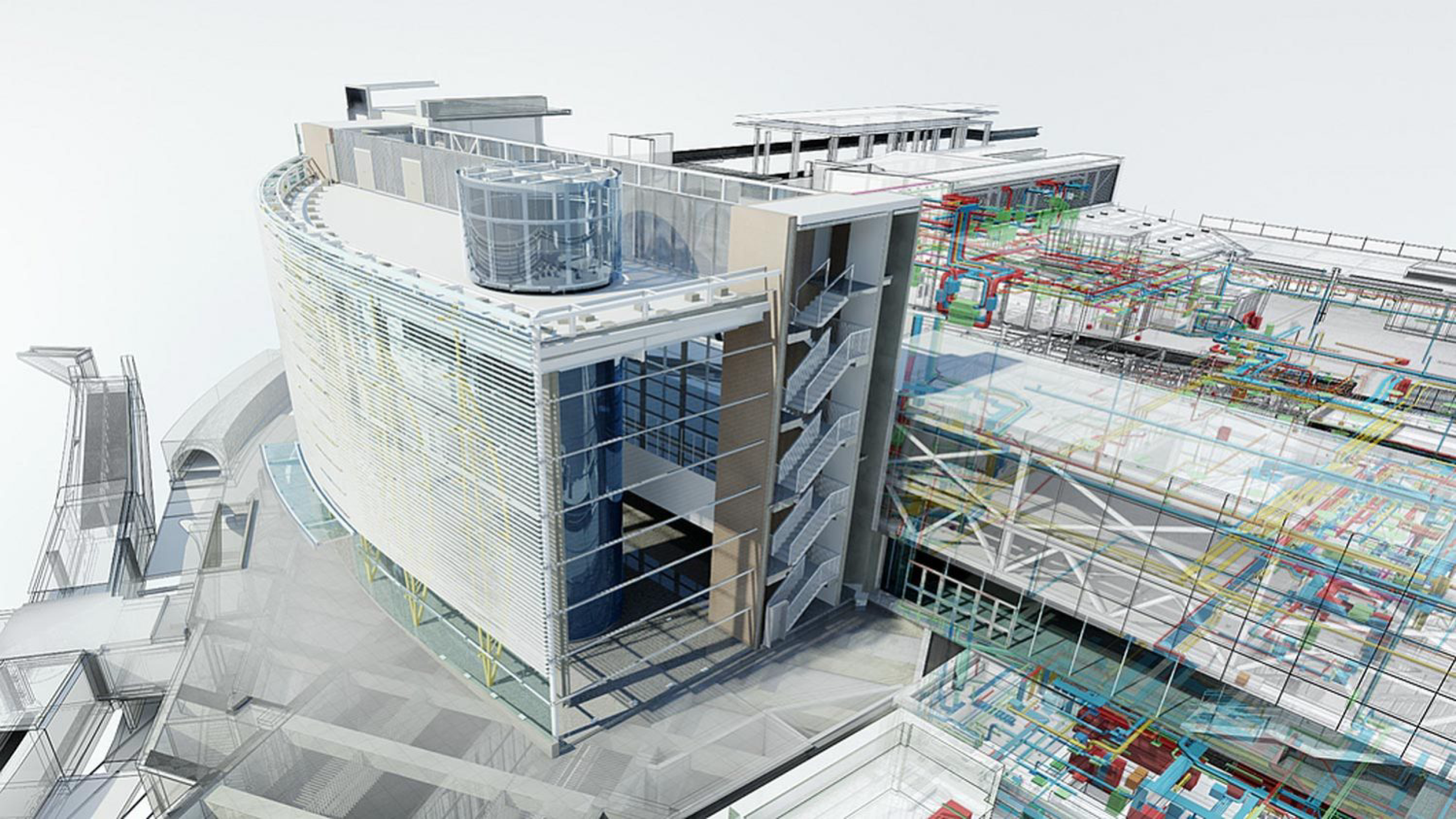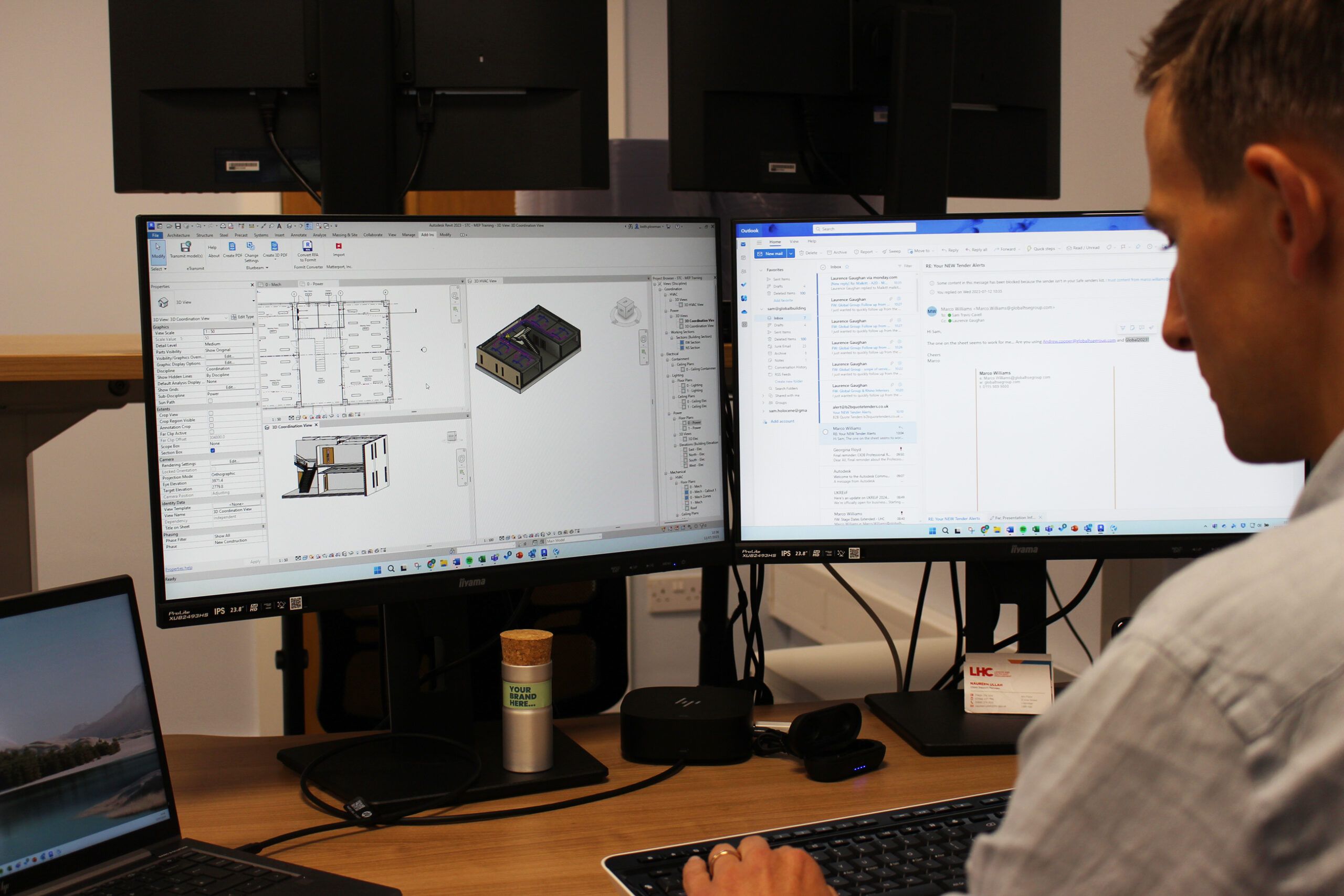
BIM Services Expertise
Building Information Modelling (BIM) provides a comprehensive process for digitally modelling, mapping, monitoring, and managing information throughout construction projects. It fosters collaboration and employs digital technologies to enhance efficiency in designing, creating, and maintaining assets. BIM incorporates vital product and asset data, as well as three-dimensional computer models, enabling effective information management throughout the project’s lifecycle, from initial concept to operation.
GBE’s BIM consultants are involved in nearly every project we undertake. It serves as our data management approach, and we also bring our specialised BIM management expertise to clients’ projects and schemes, aiming to improve efficiency, reduce risk, enhance quality, and support design collaboration.
Overall, BIM offers significant advantages throughout the entire lifecycle of a construction project, from design and construction to facility management and maintenance. It enhances collaboration, improves design accuracy, reduces errors, optimises construction processes, and supports efficient facility management, leading to cost savings, time savings, and improved project outcomes.
What is Building Information Modelling (BIM)? Your Project’s Digital Ecosystem.
- 3D Visualisation: Beyond simple geometry, BIM models offer a comprehensive visual understanding of the project.
- Data-Rich Elements: Each component in the model contains relevant data, enabling detailed analysis and information extraction.
- Collaboration Platform: BIM facilitates seamless information exchange and coordination among all project stakeholders – architects, engineers, contractors, and clients.
- Lifecycle Management: BIM supports the entire lifecycle of a building, from initial design and construction through to operation, maintenance, and even demolition.
Key Advantages of Using BIM

Enhanced Collaboration
BIM allows multiple stakeholders, such as architects, engineers, contractors, and clients, to collaborate more effectively. They can work on a shared digital model, enabling real-time collaboration, coordination, and communication. This reduces conflicts, errors, and delays during the design and construction process.

Improved Visualisation and Design
BIM provides a three-dimensional (3D) virtual model of a building or infrastructure project. This helps stakeholders visualise and understand the design more accurately, making it easier to identify potential issues, conflicts, or design flaws early in the process. It enables better design optimisation and informed decision-making.

Clash Detection and Conflict Resolution
BIM enables clash detection, where the software automatically checks for clashes or interferences between various building elements, such as structural components, mechanical, electrical, and plumbing systems. Early detection of clashes helps resolve conflicts and coordination issues before construction, reducing costly rework and change orders.

Accurate Quantities and Cost Estimation
BIM facilitates automatic quantity takeoff and cost estimation by extracting data directly from the digital model. This improves accuracy, reduces manual errors, and enables faster and more reliable cost estimation during the project lifecycle.

Reduced Rework and Waste
With BIM’s accurate visualisation and clash detection capabilities, potential errors, design flaws, and clashes can be identified early, reducing the need for rework during construction. This minimises material waste, saves costs, and improves overall project efficiency.

Improved Communication and Documentation
BIM serves as a central repository for all project-related information, including design documents, specifications, schedules, and construction details. It improves communication and collaboration among project teams, simplifies document management, and ensures that all stakeholders are working with the most up-to-date information.
Fully Accredited





Working with GBE
What sets us apart is our capability to guide clients through the complex landscape of building safety regulations, particularly those mandated for high-risk buildings following the 2021 regulatory changes.
We provide a holistic approach to BIM services, ensuring a seamless experience, as there is no need to coordinate with multiple vendors or service providers.
Our team possesses in-depth knowledge and expertise in navigating building safety regulations, particularly those related to high-risk buildings. We stay up-to-date with the latest regulatory changes and ensure that our solutions are fully compliant with these requirements.
We understand that navigating regulatory processes can be a daunting task. So, we offer personalised guidance and support to our clients, helping them understand the regulatory landscape and ensuring that their smoke vent control systems meet all necessary compliance standards.
Our clients know that their smoke vent control systems not only meet regulatory requirements but are also designed and installed to the highest standards of quality and reliability. Our end-to-end solution streamlines the process, saving time, effort, and potential headaches associated with compliance and maintenance.
Our comprehensive approach, coupled with our expertise in regulatory compliance, helps minimise the risk and liability for our clients. We take proactive steps to ensure that their buildings are safe and compliant, reducing the likelihood of fines, penalties, or legal issues arising from non-compliance.

| Sam Travis-Cavell | Head of Building Environments | Contact |

| Keith Plowman | Technical Consultant | Contact |

| Srinivas Sarath Thagapillai | Graduate Building Services and Sustainability Engineer | Contact |
Sam Travis-Cavell is a Chartered Mechanical Engineer and Head of Building Environments at Global Technical Services, leading sustainable, safety-focused construction design with advanced thermal and flow modelling, BIM, and building physics. He mentors and builds high-performing teams, integrating innovative digital tools to optimise energy performance and efficiency well before project realisation.
Keith served 18 years in the RAF Fire & Rescue Service both in the UK and abroad, working his way up to watch manager and training manager. During this time, he completed an engineering degree and joined Global in 2023, excelling with his innovative approach to problem solving, building safety and compliance, and utilising new technology.
Sustainability-focused Professional with a master’s in low energy building services engineering and a bachelor’s in architecture. Committed to delivering sustainable, high-performance buildings that align with environmental goals and client needs.
BIM Services Enquiry
Transform your construction journey with Global Building Environments’ expert BIM services. Enquire today with GBE to see how we can support you with your Building Information Modelling (BIM) needs.

Frequently Asked Questions
BIM stands for Building Information Modelling. BIM is the process of defining, creating, and delivering the structured data and documents that are used to design, create and operate any built asset – all in a centralised, accessible format that builds a single truth for all project participants.
The primary benefit of BIM is improved collaboration and communication among all project stakeholders. By providing a single source of truth – the intelligent 3D model – it drastically reduces errors, reworks, and delays, leading to more efficient and cost-effective project delivery.
BIM is often misunderstood as just software. While it utilises various software tools (such as Autodesk Revit, Navisworks, and ArchiCAD), BIM is fundamentally a process or methodology. It’s about how project information is created, managed, and exchanged collaboratively throughout the entire project lifecycle.
- 3D BIM: The intelligent graphical model itself.
- 4D BIM: Adds time and schedule data to the 3D model, enabling visual project sequencing and planning.
- 5D BIM: Adds cost data to the 3D model, enabling automated quantity take-offs and real-time cost estimations.
- 6D BIM: Adds lifecycle and operational data to the model, supporting facilities management, energy analysis, and asset management post-construction.
While there isn’t a strict legal mandate for all projects, the UK government’s Construction Strategy encourages and in some cases requires the use of BIM. For example, BIM Level 2 (now aligned with ISO 19650) was a requirement for centrally procured government projects. Many private clients also now mandate BIM for their projects due to the proven benefits.
BIM can significantly contribute to sustainability by enabling:
- Energy Performance Analysis: Simulating building performance to optimise energy consumption.
- Material Optimisation: Calculating precise material quantities to reduce waste.
- Daylighting and HVAC Analysis: Designing for optimal natural light and efficient heating/cooling systems.
- Lifecycle Assessment: Understanding the environmental impact of materials and systems throughout the building’s life.
BIM can be used to create “as-built” models of existing buildings, often by using laser scanning or photogrammetry to capture existing conditions. This ‘digital twin’ can then be used for refurbishment projects, facilities management, energy efficiency upgrades, or heritage preservation.